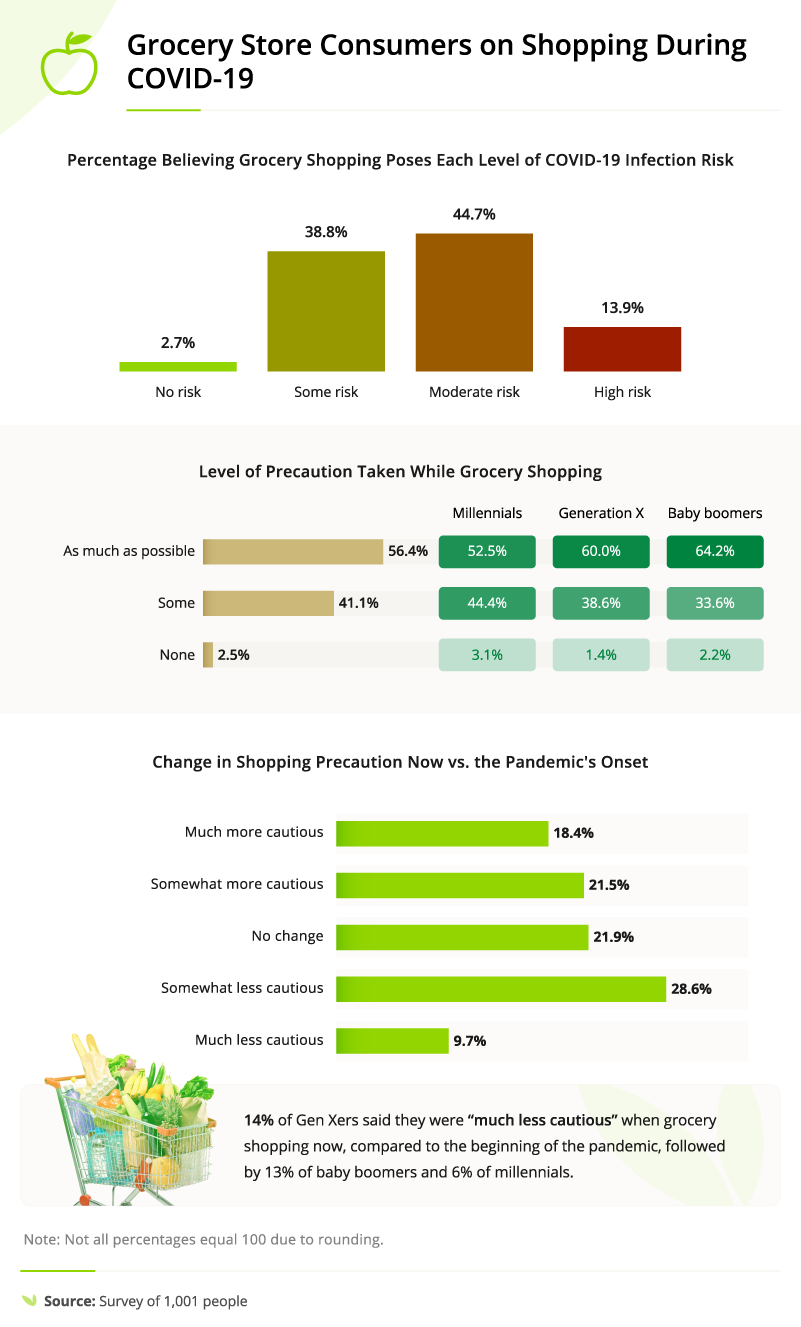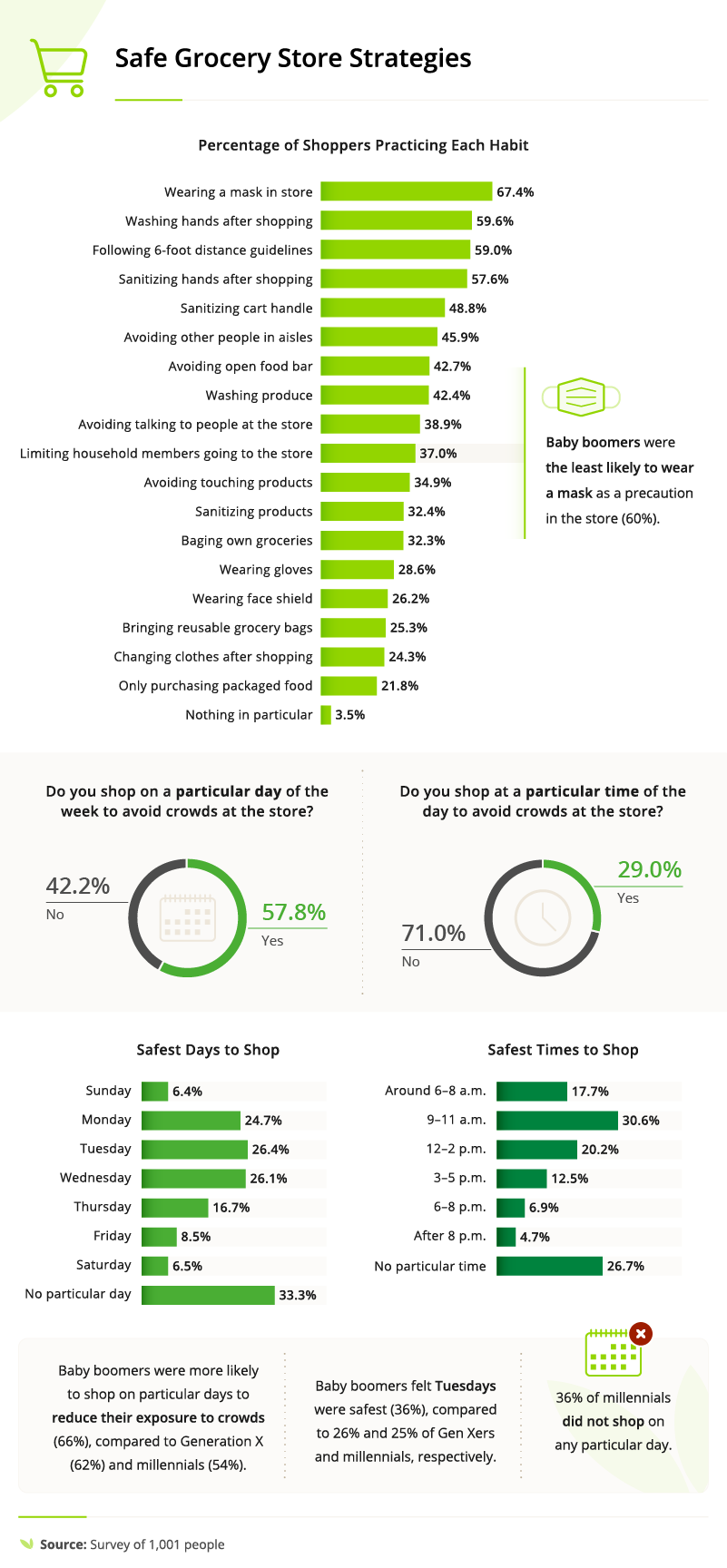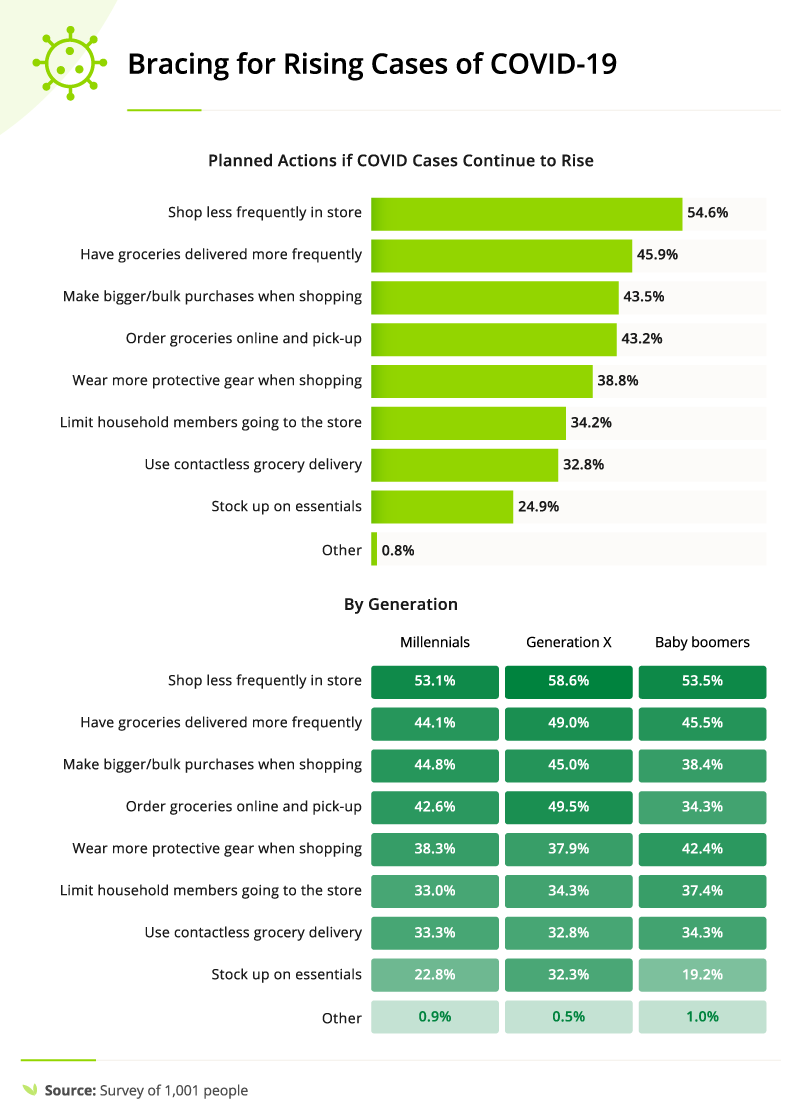Grocery Store Shopping Habits During COVID-19
Grocery Store Shopping Habits
During COVID-19
It would be difficult to name a segment of our everyday life that has not been affected by the COVID-19 pandemic.
Whether it’s the decision to pick up takeout rather than dine at a favorite restaurant or the choice to order groceries to be delivered rather than venture out into a supermarket, we are all faced with new choices and decisions we may not have thought twice about last year.
Simple, everyday tasks in a pandemic now carry a risk of exposure to COVID-19, so much so that there are recommended guidelines to limit exposure.
We wanted to explore just how much things have changed for grocery shoppers during COVID-19 and the many strategies shoppers are practicing to stay safe from infection.
We surveyed over 1,000 people to explore their perspectives on the risks of grocery shopping this year and asked shoppers what they might do as cases continue to rise. Read on to see how consumers are approaching grocery stores amid a pandemic.
A Snapshot on Precautions
There’s no doubt that opinions vary over the necessity to take precautions to combat COVID-19.
Where a vast majority of respondents agreed, however, was that in-person shopping comes with at least some risk. In fact, only 3% of the shoppers surveyed believe there is no risk of exposure to COVID-19 while grocery shopping.
Around 14% of our survey respondents even viewed grocery shopping as a high-risk activity. When asked about the levels of precaution taken, over half reported that they take all the precautions they can at the store.

There is certainly some disparity between generations when it comes to limiting exposure to COVID-19 at the grocery store.
Though over half of millennials reported taking all the precautions they could while grocery shopping, they were also the group most likely to take no precautions at all. Baby boomers were the most cautious, with 64% of respondents taking all precautions possible while shopping in store.
While the pandemic has stretched on for months across the country, some respondents have experienced what experts are calling “pandemic fatigue.” Despite upticks in cases around the country, some shoppers have let their guards down or have simply grown tired of donning their mask and taking the usual level of precaution as when the outbreak first started.
Our study found that 29% of respondents admitted to being “somewhat less cautious” at the store than they were when the COVID-19 outbreak started, and nearly 10% even said they were much less cautious, which shows pandemic fatigue clearly seems to be impacting shopping habits.
Shoppers of Habit
The most popular way respondents protected themselves in the grocery store was by wearing a mask, with 67% wearing a facial covering while shopping.
The Centers for Disease Control and Prevention (CDC) reports that masks are an effective way to limit the spread of the virus through respiratory droplets, and though baby boomers felt they should take all the precautions they needed when shopping, they were somewhat less enthusiastic about mask-wearing in store, as only 60% reported wearing a mask on their trips.

Some respondents changed social behaviors in order to reduce their risk of exposure to COVID-19: Around 39% of respondents avoided talking to other shoppers, and 46% avoided people in the aisles entirely.
Other shoppers took it a step further, with about 24% of respondents saying they changed their clothes after a shopping trip.
Among those designating a particular time to visit the grocery store, weekends and evenings were deemed the least safe times to get in-person shopping done – the most popular times among respondents were Monday through Wednesday and before 5 p.m.
Reactions to a Second Wave
Daily reported cases of COVID-19 across the U.S. have increased in record numbers in the past few months, and Americans are likely to be faced with tough decisions regarding their in-store shopping habits if cases continue to rise.
Around 55% of respondents said a rise in cases would mean shopping less frequently, while 39% said they would at least wear more protective equipment while shopping.
Delivery services may also experience a spike in grocery orders, as 46% of respondents said they would utilize grocery delivery more frequently, with 33% favoring contactless drop-off.

Grocery shopping strategies differed slightly by generation in regards to how shoppers would respond to rising cases of COVID-19.
Generation Xers were not only the most likely to cut down on in-store shopping but were also the most likely to stock up on essentials, increase their online grocery shopping frequency, and make bigger or bulk purchases of goods.
Baby boomers were the most likely respondents to increase their personal protective gear while shopping (42%), but the least likely to stock up on essentials (19%).
Millennials said they would shop in store less frequently and just slightly favored ordering groceries for pick-up over delivery.
Grocery shopping in 2020 is a completely different experience than Americans have come to know.
Shoppers have had to make decisions daily to try to protect themselves and their families against exposure to COVID-19.
And though there are strategies to reduce your risk while shopping in store, Mercato provides consumers with a convenient way to shop virtually and have their groceries delivered right to the door.
Mercato provides shoppers with an easy-to-use alternative to in-person shopping, without the crowded aisles, so you can browse and purchase all of your favorite items without the stress of shopping during a pandemic. Visit Mercato today to see how you can shop for your daily essentials from the comfort of your own home.
Methodology and Limitations
We surveyed 1,001 respondents ranging in age from 18 to 74 in order to explore how grocery shopping habits have changed since the outbreak of COVID-19.
The average age of our respondents was 39 with a standard deviation of 12 years. Around 55% of our respondents were millennials, 29% were from Generation X, and 13% were baby boomers.
A small portion of our respondents were Generation Z (3%) but were excluded from generational analysis due to insufficient sample size. 47% of our respondents were women, 53% were men, and less than 1% identified as nonbinary.
Self-reported data, such as that from our survey, have limitations due to aspects, such as telescoping, exaggeration, and selective memory. We didn’t weight our data or statistically test our hypotheses, as this was simply an exploration of the topic of grocery shopping and the strategies people use (or don’t) to protect against COVID-19 infection.
Fair Use Statement
Are you doing your part to protect yourself and others against COVID-19 while shopping for your essentials? In the case of this study, sharing is caring. Feel free to post our study or share with friends who are also navigating the shopping aisles during COVID-19, but please do so only for noncommercial purposes and link back to this study so we receive proper credit for our work!
